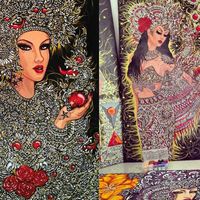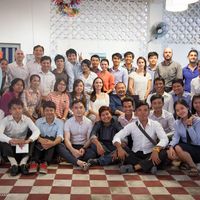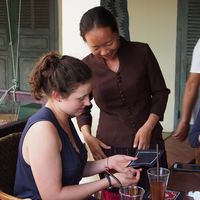Sok Sabai | Good news from Cambodia
 In 2015, culture360 invites you to get an insight on issues that are highly discussed in the cultural sector across Asia and Europe.
In 2015, culture360 invites you to get an insight on issues that are highly discussed in the cultural sector across Asia and Europe.Through a number of in-depth articles and interviews, Magali An Berthon will initiate a reflexion about a creative generation which connects arts, design, crafts and social responsibility. She will introduce European and Asian personalities and initiatives, which offer original and inspiring answers to a globalized world.
In this third article, Magali An highlights the insightful case of the web documentary "Sok Sabai, Good News from Cambodia." This online documentary about NGOs, which offering simple solutions to improve the daily lives of rural Cambodian people, exemplifies how digital platforms have become a great medium to inform an audience with interactive didactic content, and bring other ways to tell stories of the world.
French reporters Romain Auzouy and Sibylle Véron co-directed “Sok Sabai”—“How are you” in Khmer language—, a web documentary which took place in Cambodia and released on the website of the international french radio, RFI. It features five inspiring reports, which focus on a handful of NGOs with local impact. Through photos and short videos, the initiative cleverly addresses some of the major social issues of Cambodia such as education, agriculture, and economy, by following five Cambodians with compelling paths. The enthusiast journalistic duo agreed to share the genesis of this original project.
1- Romain and Sybille, could you tell us about your respective careers and interests?
Romain: I have been a journalist since 2004. I worked for seven years at Radio France and started at RFI radio in 2011 as a host. I also freelanced for Infosport on sports news topics. I enjoy diversifying my activities, but my main interest lies in international themes in particular.
Sibylle: Initially an editorial assistant at Europe 1 radio, I trained in video journalism to broaden my horizon. I like to work on images from the frame to the narrative. And I was really tempted by the web documentary experience. I currently work for the show La Quotidienne on France 5 channel. Social, educational, economical, and agricultural topics are my favourite.
2- Why Cambodia? Tell us about the genesis of “Sok Sabai”.
R.+S.: For a while, we wanted to develop a project in line with the rising movement of positive impact journalism. For us, talking about problems is a way to solve them. The release of the book "One million peaceful revolutions” in 2012, in which reporter Benedicte Manier tells the story of inspiring initiatives happening all over the world, encouraged us to launch our project. We were fascinated by the commitment of some who would use their skills to help others, to push a country forward, and to fill the void left by governments. Our duty as journalists is to relay their stories.
Our preliminary research determined our choice to focus on Cambodia. Besides our personal interest for South East Asia, we found out that amazing things were happening there. Between the unprecedented workers’ protests and the recent Khmer Rouge trials, we felt that it was the right time to explore this country which is experiencing a shift. We wanted to see this change with our own eyes.
3- Why did you choose the web-documentary format to narrate your stories?
R.+S.: The web documentary perfectly met our expectations. We imagined a simple platform which would allow us to put together a collection of positive reports, with an engaging "postcard" feeling to it as an invitation to travel. However, our first idea evolved, thanks to the support of the France World Media multimedia team. We also plan to reach a Khmer audience, so a translated version is currently in development. The Cambodian people are more and more connected: the number of tablets and smartphones has exploded, and now, even monks have one! Simultaneously, RFI just opened an editorial branch in Phnom Penh with its own website, so it felt very appropriate.
4- Your five stories depict a rural country facing many social challenges. How did you manage to show another face of Cambodia besides the temples and the civil war?
R.+S.: This is precisely what drove us to Cambodia. What a burden it is to be just considered as the land of the Khmer Rouge! After Pol Pot's demise, a lot of NGOs arrived, which conveyed the image of a country infused with international help. In this profusion of organizations, we wanted to promote those involved in self-empowerment programmes. In other words: those placing the people at the heart of their initiative and liberating them from external dependence.
5- Your portraits of the Cambodians are very endearing. Did you have one particularly memorable encounter?
R.+S.: We were pleased with the final result, as it seems to us that the five stories are quite balanced. We chose these people because they all had something to say. Of course, some meetings were more memorable than others.
Romain: I immediately thought of Stephen Sumner although he is not a Cambodian! But I have never met someone with such mental strength: the amputated man bikes through all of Asia to share a therapy that changed his life! Tchreb—from the story "The Girl of the Temples"—was our first meeting in Cambodia, so she left us with an unforgettable memory. I also remember Touy from "The School of Light." He seemed very shy when we first met, but he truly revealed himself at night, facing the camera after his fishing trip.
S.: The Cambodians really moved us with their radiant smiles, their sense of humour, and their candor.
6-Do you have new projects in the works?
R.+S.: Since our return, we have resumed our activities as journalists in Paris and we are happy with it. Nothing is planned for now, but of course we would love to start a new project. Perhaps in Cambodia, as we still continue to follow their news! Or possibly in another country, somewhere in Africa. This is the meaning of our work and our lives.
“Sok Sabai, Bonnes nouvelles du Cambodge” http://webdoc.rfi.fr/cambodge-sok-sabai/#/home
"One million of peaceful revolutions": http://www.franceinter.fr/personne-benedicte-manier
Writers and producers: Romain Auzouy and Sibylle Véron
Coproduction: RFI, France World Media
Photo Credits Sybille Véron
Magali An Berthon is a French Vietnamese textile designer and editor based in Paris. Graduate of the National School of Decorative Arts in Paris, she has gathered a valuable experience as a textile designer for fashion and home collections. She finds inspiration in her many travels especially in South-East Asia and has developed a deep interest for ethnic arts & crafts, natural fabrics and dyes. In parallel, she works as a writer and documentarist specialized particularly on textile know-how from all over the world.







